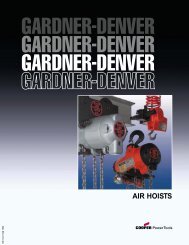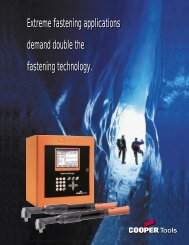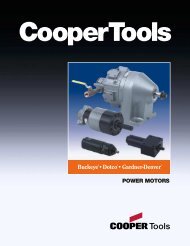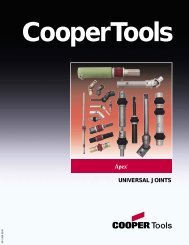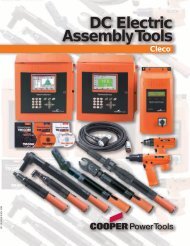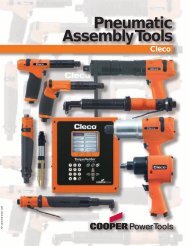Airetool Tube Cleaner and Expanders Catalog - Tecno Italia s.r.l
Airetool Tube Cleaner and Expanders Catalog - Tecno Italia s.r.l
Airetool Tube Cleaner and Expanders Catalog - Tecno Italia s.r.l
You also want an ePaper? Increase the reach of your titles
YUMPU automatically turns print PDFs into web optimized ePapers that Google loves.
102<br />
Technical Information<br />
Cutting Speeds<br />
Speed, Feed & Power<br />
Please use the chart below as a<br />
guide only. Many variables contribute<br />
to the optimum parameters for each<br />
application. These variables include:<br />
particular material characteristics,<br />
cutter design, cutter sharpness,<br />
airline pressure <strong>and</strong> flow capacity<br />
<strong>and</strong> cutter lubrication.<br />
All portable drilling tools have limited<br />
power <strong>and</strong> thrust. In most cases,<br />
holes over 1/2 inch diameter cannot<br />
be produced at machine tool rates.<br />
Feed rates <strong>and</strong>/or speeds are<br />
reduced. Consult CooperTools for<br />
advise on particular applications.<br />
For best results with your drilling system:<br />
1. Maintain lubricated air to the tool with pressure of 90 psig<br />
while the tool is running.<br />
2. Use high quality cutters.<br />
3. Replace cutters when point dulls – hole diameter generally increases,<br />
cycle times lengthen (except positive feed) <strong>and</strong> hole finish worsens.<br />
4. Whenever possible, provide lubricant mist to the drill point.<br />
5. Insure there is an adequate flow path for drill chips (swarf).<br />
6. Utilize fixtures that are secure <strong>and</strong> rigid.<br />
7. Assure that accessory items are sized correctly <strong>and</strong> working properly.<br />
8. Train operating personnel in the proper use of the tool.<br />
9. Please consult the machinery h<strong>and</strong>book for optimum<br />
cutting feeds <strong>and</strong> speeds.<br />
1/8 3/16 1/4<br />
Drill Diameter<br />
5/16 3/8 7/16 1/2<br />
Material Function .125 .188 .250 .313 .375 .437 .500<br />
Aluminum (300 SFM) Speed (RPM) 9000 6000 4600 3600 3000 2600 2300<br />
Feed Rate (IPR) .002 .003 .004 .004 .004 .004 .004<br />
Power (HP) .2 .3 .6 1.0 1.5 1.8 2.0<br />
Mild Steel (90 SFM) Speed (RPM) 2700 1800 1300 1100 900 750 650<br />
Feed Rate (IPR) .005 .005 .005 .006 .006 .006 .006<br />
Power (HP) .2 .3 .6 1.0 1.5 1.8 2.0<br />
High Strength Steel Speed (RPM) 900 600 450 375 300 250 220<br />
Stainless Steel Feed Rate (IPR) .001 .001 .001 .001 .001 .001 .001<br />
(30 SFM) Power (HP) .2 .3 .6 1.0 1.5 1.8 2.0<br />
Titanium/Inconel Speed (RPM) 600 400 300 250 200 175 150<br />
(20 SFM) Feed Rate (IPR) .002 .003 .003 .003 .004 .004 .005<br />
Power (HP) .2 .3 .6 1.0 1.5 1.8 2.0<br />
Composites Graphite, kevlar, fiberglass, <strong>and</strong> other composite materials vary widely. Fiber, resin, processing method <strong>and</strong><br />
type of cutting tool all affect the optimum drilling speed <strong>and</strong> feedrate. Little power or thrust is normally<br />
required, but controlled feedrates at the proper speed is m<strong>and</strong>atory. Carbide or diamond cutting tools are<br />
required. Contact your material supplier or experiment with an NC Drilling Machine.<br />
Stacks of Various Materials Use the lowest speed <strong>and</strong> feedrate of the materials in the stack. Peck feed drilling is best.<br />
A. Peck Drilling permits higher drilling speeds B. Carbide cutting tools (when applicable) permits higher drilling speeds C. Oil hole cutting tools permit higher drilling speeds.<br />
Speed (RPM)<br />
Describes the number of revolutions<br />
of the spindle per unit of time.<br />
Example: Revolutions per minute=RPM<br />
Surface Speed (SFM)<br />
Describes the velocity (speed) of the<br />
outside of the drill bit.<br />
Example: 30 surface feet per minute (30 SFM)<br />
Feed Rate (IPR)<br />
Describes the distance the spindle travels<br />
during each revolution.<br />
Example: 0.002 inches per revolution = .002 IPR<br />
1 Revolution Time<br />
A<br />
Time<br />
1 Revolution<br />
Velocity at point A<br />
Distance<br />
Speed = Revolution ÷ Time Surface = Distance ÷ Time<br />
Feed Rate = Distance ÷ Revolution<br />
Speed (rotational)



